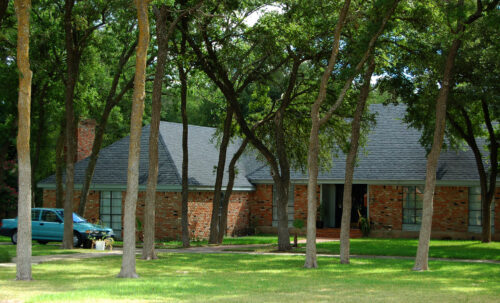 In designing and building your Firewise home, the two main goals are to reduce the flammability of the house and reduce exposure to a wildfire.
In designing and building your Firewise home, the two main goals are to reduce the flammability of the house and reduce exposure to a wildfire.
Here are key suggestions that meet these important goals:
- Use construction materials that are fire-resistant or non-combustible whenever possible.
- For roof construction, consider using materials such as Class-A asphalt shingles, slate or clay tile, metal, cement and concrete products, or terra-cotta tiles.
- Constructing a fire-resistant sub-roof will add protection, as well.
- For exterior wall siding, fire-resistant materials such as stucco or masonry are much better than wood or vinyl (which can soften and melt).
- Windows can break easily when exposed to fire, opening up a path for fire to enter the house. Tempered glass is more resistant to breakage than single or double pane glass. Use this for the largest, most exposed picture windows. Smaller panes (less than two feet wide) hold up better in their frames than larger ones when exposed to fire. Try using multiple smaller panes rather than one large one.
- Plastic skylights can melt, and allow fire to drop into a house. Non-flammable covers can be made for skylights and windows.
- To prevent sparks from entering your home through vents, cover exterior attic and underfloor vents with wire mesh no larger than 1/8 of an inch; make sure soffit vents are closer to the roof line than the wall; and box in eaves, but provide adequate ventilation to prevent condensation.
- Include a driveway that is wide enough for firefighting vehicles: 12 feet wide with a vertical clearance of 15 feet and a slope that is less than 12%. The driveway and access roads should be well maintained, clearly marked, and include ample turnaround space near the house.
- Ensure clear access to any water supply, if possible.
- Keep gutters, eaves, and roof clear of leaves and other debris.
- Make an occasional inspection of your home, looking for deterioration such as breaks and spaces between roof tiles, warping wood, or cracks and crevices where sparks can gather.
- Inspect your property, clearing dead wood and dense vegetation from at least 30 feet around your house, and move firewood away from the house, decks or fences.
- Any structures attached to the house, such as decks, porches, fences, and outbuildings, should be considered part of the house. These structures can act as fuses or fuel bridges, particularly if constructed from flammable materials.
- Prevent combustible materials and debris from accumulating beneath decks or elevated porches; screen or box in these areas.
- Make sure an elevated wooden deck is not located at the top of a hill where it will be in direct line of a fire moving up slope; consider a terrace instead.
- If you wish to attach an all-wood fence to your home, use masonry or metal as a protective barrier between the fence and house.
- Use non-flammable metal when constructing a trellis and cover with high-moisture, nonflammable vegetation.
Additional Resources
| Image | Title | ID | Description | Date | Content Type | View | hf:tax:document-category | hf:tax:Media |
|---|---|---|---|---|---|---|---|---|
| Firewise Communities for Virginia | P00111 | Brochure provides important steps to protecting your home and community from wildfire, including firewise landscaping, defensible space, fire-resistant roof and exterior construction, fire-resistant attachments, steps to becoming a firewise community, a disaster plan, defensible space, and emergency access. Printed copies available. | 12/31/2021 | Publication | View | fire-and-emergency-response | publication | |
 | Home Wildfire Safety Checklist – Is Your Home Firewise? | FT0002 | Forestry topic information sheet provides a checklist of items to answer about your home to assist in identifying characteristics of your home that may require changes to improve the wildfire safety of your home. | 08/01/2014 | Publication | View | fire-and-emergency-response | publication |
 | Is Your Home Safe from a Wildfire | Publication providing guidance on protecting homes from wildfire hazards. Printed copies available. | 01/01/2011 | Publication | View | fire-and-emergency-response | publication | |
| Firewise Landscaping Part 1: Overview | Video providing an overview of Firewise landscaping practices for wildfire protection. Part 1 of 3. | Video | View | fire-and-emergency-response | video | |||
| Firewise Landscaping Part 2: Design and Installation | Video covering design and installation techniques for Firewise landscaping. Part 2 of 3. | Video | View | fire-and-emergency-response | video | |||
| Firewise Landscaping Part 3: Maintenance | Video covering maintenance practices for Firewise landscaping. Part 3 of 3. | Video | View | fire-and-emergency-response | video |
Contact Us
For more information or questions, e-mail us or use our contact form.
